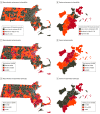Disparities in SARS-CoV-2 Testing in Massachusetts During the COVID-19 Pandemic
- PMID: 33560423
- PMCID: PMC7873783
- DOI: 10.1001/jamanetworkopen.2020.37067
Disparities in SARS-CoV-2 Testing in Massachusetts During the COVID-19 Pandemic
Erratum in
-
Error in Figure 2.JAMA Netw Open. 2021 Apr 1;4(4):e2110970. doi: 10.1001/jamanetworkopen.2021.10970. JAMA Netw Open. 2021. PMID: 33890999 Free PMC article. No abstract available.
Abstract
This cohort study examines disparities in severe acute respiratory syndrome coronavirus 2 (SARS-CoV-2) testing during the coronavirus disease 2019 (COVID-19) pandemic in Massachusetts.
Conflict of interest statement
Figures


Update of
-
SARS-CoV-2 Testing Disparities in Massachusetts.medRxiv [Preprint]. 2020 Nov 4:2020.11.02.20224469. doi: 10.1101/2020.11.02.20224469. medRxiv. 2020. Update in: JAMA Netw Open. 2021 Feb 1;4(2):e2037067. doi: 10.1001/jamanetworkopen.2020.37067. PMID: 33173919 Free PMC article. Updated. Preprint.
References
-
- US Census Bureau Selected household characteristics from 2014-2018 American Community Survey (5-year estimates). Published 2019. Accessed September 23, 2020. https://www.census.gov/data/developers/data-sets/acs-5year.html
Publication types
MeSH terms
Grants and funding
LinkOut - more resources
Full Text Sources
Other Literature Sources
Medical
Miscellaneous

